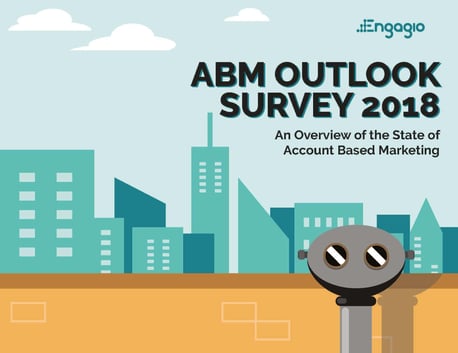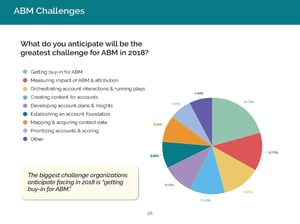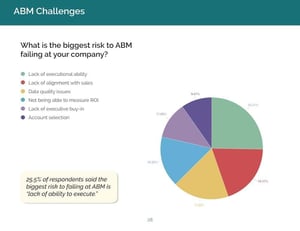Concerning News From Engagio's ABM Outlook Survey
 Unless you're some modern day Rip Van Winkle you're well aware of the account based marketing buzz of the last couple years. ABM can be incredibly effective as a supplement to other demand and lead gen programs, particularly for companies with strong sales & marketing alignment and those with thoughtful account targeting and strategic account sales programs.
Unless you're some modern day Rip Van Winkle you're well aware of the account based marketing buzz of the last couple years. ABM can be incredibly effective as a supplement to other demand and lead gen programs, particularly for companies with strong sales & marketing alignment and those with thoughtful account targeting and strategic account sales programs.
But, it's not a layup. In fact it's a lot of work and effective execution requires thoughtful vision and cerebral execution.
Engagio's recently released "ABM Outlook Survey 2018: An Overview of the State of Account Based Marketing" recaps the findings of their survey of 1,260 companies currently using ABM.
The report uncovered some challenges and risks which can impede or cripple ABM programs.
 Among these were (click the images for larger versions):
Among these were (click the images for larger versions):
- 18% fear that data quality issues are the biggest risk to their program
- 21% believe their biggest challenge will be getting buy-in for the program - one of the biggest barriers to buy-in is missing KPIs to clearly justify the programs. 4 other challenges listed contribute to the difficulties in tracking effectiveness
- 12.8% worry about measuring the impact and attribution
- 12.6% worry about orchestrating interactions and running plays
- 10.2% are unsure about developing account plans and insights
- 8.9% worry about mapping and acquiring contact data
 In sum, fully 65% of respondents see challenges related to lack/quality of data.
In sum, fully 65% of respondents see challenges related to lack/quality of data.
That's a stiff headwind for account based marketing.
It's not insurmountable however. Some analysis and tips follow, including the potential to use buyer intent data to help sales teams and marketing campaigns leverage a combination of a company's first party intent data and third party intent data to better align the sales process with customer behavior.
Accounts vs. Individuals
Who makes buying decisions? Who (or what) are your potential buyers? It's not accounts. On that we can certainly agree.
Our sales language pretends it's individuals, but there's ample evidence that it's rapidly growing buying teams which decide by consensus. Those teams are small collections of individuals with individual and an aggregate buying cycle.
That's challenging for sales teams. If you're selling a complex manufacturing solution to a buying team from a large CPG company, for instance, there will likely be buying team members representing plant engineering, corporate engineering, controls, IT, safety, HR, plant maintenance, corporate finance and plant management. It's often not tied closely to seniority or title.
With a workforce of tens of thousands, the fact that a few people from the company may have seen/"engaged with" your messaging is of almost no consequence in moving a buying team further along - regardless of where they are in the buying journey.
You have to influence, engage and connect with the handful of people involved. That requires segmented and personalized marketing and sales approaches. Yet, while personalized marketing and effective sales can provide a competitive edge, they are predicated on knowing who is/could actively participate in a purchase and where they are in their buying journey.
In sophisticated and patient execution of large account ABM focused on the C-Suite, this is managed by using data tools to research the org chart and target those who you want to sell to - and sticking with it for a couple years with completely individualized content and campaigns.
In most applications of ABM, however, that means correlating engagement activities with actual people at multiple levels in the organization.
And that's the Achilles heal of ABM as it's practiced at scale by most companies.
There's a solution.
Buyer Intent Data Could/Should Connect the Contact Dots for ABM
Some will argue that all that's needed is just to cast a wider net (even though ABM is predicated on spear fishing in contrast to a wider net!) - to enroll more contacts from a company in ABM workflows. If that's true, then simply downloading larger lists from RainKing (DiscoverOrg) would do the trick.
It doesn't, of course, because those are just random individuals. And random individuals, whether pulled from static lists or presumed based on anonymous activity, are just....random - they're not appropriate targets for marketing initiatives or likely to directly generate revenue. And so while buyer intent data is often proposed as a fix for this shortcoming in ABM, it typically perpetuates the challenge with "contacts" which are derived from anonymous IP based activity observations and "overlaid" (that's a euphemism for B#%^$?!t) contact details pulled from another source.
Most buyer intent data fails to deliver this. It's not accurate data. An honest description of the lead would sound something like "someone at XYZ company facility looked at your competitor's website, and since we know you'd like to talk to the VP of Engineering, here are his/her contact details that we happened to find, completely unrelated, in LinkedIn Sales Navigator." That's not interpreting buyer intent or leveraging buyer intent signals. That's a guess.
However, when Buyer Intent Data delivers actual contact details, it provides an effective compliment to account based marketing which addresses nearly all of the data risks and challenges captured in Engagio's data.
That's what Sales Fracking™ Buyer Intent Data does.
The description of a Sales Fracking lead sounds like "You said you wanted to know when a VP of Engineering from a firm in XYZ industry with this many employees, located in this geography, took action around this key term (or competitor, or influencer, or event) - Jane Smith meets those criteria, and just took action on LMN competitor's site. Here are her company, title, email address, main phone, Twitter handle and LinkedIn profile."
That's actionable information! That's effective intent data.
Real Buyer Intent Data Driving ABM
Actual contact actions and buying trigger context (what someone did and where) are the allure of buyer intent data, and the power is realized with the addition of actual contact details. But how can your sales team use this purchase intent insight effectively to improve ABM outcomes?
Like much in digital marketing it's simple, but not easy.
Sales Fracking buyer intent data provides the key details to inform the process.
- title - you can gauge their role in the decision by department and seniority
- trigger - what they've taken action on (what competitor, key term, influencer, etc.)
- source - where they've taken action (competitor's website, elsewhere on the web)
- additional key contacts - others who the algorithm finds are likely involved in the discussion by virtue of their online behaviors which might not yet meet the threshold criteria of the algorithm, but indicate they're somehow participating
With that target audience information you can segment leads and enroll them in nuanced ABM plays depending on what you infer from their role and actions. Of course that means that you'll need varied and nuanced plays, which in turn will require that you understand the business outcomes and barriers from the perspective of each of the departments/roles involved.
Once you've done the segmentation, and created the plays, you'll be able to apply it at scale.
You'll also have the opportunity to get very personal too. Since you'll know who the actual people are from this purchase intent data, you'll be able to include personal contact from the right strategic account manager, including emails, phone calls, actual physical mail, event connections, social touches, and more. Key contacts often provide sales intelligence to your team working through a deal champion with a buying team.
 Virtual Spear Fishing....finally
Virtual Spear Fishing....finally
The ABM Martech community has pushed the visualization of account based marketing as the spear fishing analog to inbound marketing's net approach. That's an interesting way to see it, and DemandGen has reinforced that analogy.
But when ABM is pursuing nameless, faceless, anonymous employees of a target account, that's akin to blindfolded spear fishing. One doesn't have to ponder how that turns out. It doesn't end well!
If you want to spearfish responsibly (whether that means safely, or prudently with your company's ABM dollars) you have to see clearly where you're aiming.
ABM hasn't solved that in general yet, and that's why there are such profound concerns around data, measurement and buy in. Buyer intent data holds promise, but most fails to deliver. Sales Fracking Buyer Intent Data, however, largely resolves this issue and provides the key to successful ABM at scale.
One Other Thought
Really well executed ABM also requires sensible target account selection. It's remarkable how few companies have a framework for doing this in a consistent way that maps to company strategy. Often sales reps are asked to submit a list of goal accounts - and that's it. Maybe there's a national accounts group which is targeted based on opportunity size. Rarely, however, do small and middle market industrials map market trends into the future and work that, and other strategic factors, into a formal, consistent framework for identifying and prioritizing target accounts.
That's a huge missed opportunity that illustrates the role of corporate strategy in sales and marketing, and in the importance of sales and marketing alignment.
Tips for Leveraging Buyer Intent Data in Industrial Sales: A Comprehensive Approach
Harnessing the Power of Intent Data for Enhanced Sales and Marketing Alignment
 Industrial sales, or even B2B complex sales in general, is gradually recognizing that using buyer intent data can help. This intent data, collected from various sources, offers invaluable insights into customer behaviors and preferences, guiding sales teams to fine-tune their approach. The integration of both first and third party data, including b2b buyer intent data, enables a more targeted and efficient sales process.
Industrial sales, or even B2B complex sales in general, is gradually recognizing that using buyer intent data can help. This intent data, collected from various sources, offers invaluable insights into customer behaviors and preferences, guiding sales teams to fine-tune their approach. The integration of both first and third party data, including b2b buyer intent data, enables a more targeted and efficient sales process.
The Role of Buyer Intent Data in Identifying Qualified Leads
One of the core benefits of leveraging intent data is its ability to identify qualified leads. This data provides a clear picture of prospective buyers who are actively researching online, thereby allowing sales teams to focus their efforts on potential customers most likely to convert. By understanding where these prospects are in the buyer journey, sales reps can deliver relevant content and engage in meaningful customer interactions.
Utilizing Third Party Data Providers for Enhanced Market Insight
The use of third party data providers in this context is crucial. These providers offer a wealth of information that complements a company’s first party data. By integrating insights from these external sources, businesses gain a comprehensive view of the market and customer behavior. This holistic perspective is essential for developing effective marketing strategies and tailoring sales processes to meet the needs of existing customers and prospects alike. The importance of this integration is often overlooked by intent data vendors who gloss over details about how their buyer intent data is collected and lack deep expertise in how sales and marketing teams should use it.
How Intent Data Reinforces Marketing Efforts and Sales Alignment
The strategic application of intent data significantly bolsters marketing efforts. By understanding the specific interests and needs of potential customers (some insight into their buyer intent), marketing teams can create more targeted and effective campaigns. This alignment between sales and marketing is further enhanced through the use of B2B intent data tools that track and analyze customer interactions, ensuring that both teams are working towards common objectives.
The Impact of Intent Data on Sales Processes and Customer Engagement
B2B buyer intent data can be a powerful tool for revenue growth teams and an individual sales rep. Sales reps equipped with this data can better understand the needs and preferences of their leads, allowing for more personalized and effective sales pitches. This data-driven approach ensures that sales teams are not just reaching out to any potential customer, but are engaging with those who have shown a genuine interest in the products or services offered. Combining first party intent data with sales data from third party sources helps to create an integrated understanding of buying teams,
The Importance of First Party Data in Understanding the Buyer Journey
While third party data provides a broad market perspective, first party data offers deep insights into the buyer journey of existing customers. This information is crucial for refining sales strategies and ensuring that the customer’s needs are met throughout their buying process. By analyzing this data, businesses can identify patterns and trends that inform future marketing and sales initiatives.
Maximizing Sales and Marketing Effectiveness with Intent Data
The integrated use of buyer intent data, with b2b intent data, first party intent data, second party intent data, and third party data, is instrumental in enhancing the effectiveness of sales and marketing efforts in the industrial sector. By providing a detailed understanding of prospective buyers, qualified leads, and customer behavior, intent data enables businesses to tailor their strategies to meet the evolving needs of their market. Leveraging this data not only aligns sales and marketing efforts but also ensures that customer interactions are relevant and impactful, ultimately driving growth and success in the competitive world of industrial sales.


